Eleanor Adair
Described as a tall and stately brunette, Eleanor Adair was born Eleanor Agnes Hanley in Liverpool, Lancashire in 1864, the youngest of five children to parents Joseph Hanley [1831-1895] and Agnes Hanley [1832-1869] née May, so was made motherless early in her life.
In 1885, Eleanor married Ranald William Edward Huntley Nicholson [1858-1936] in Dublin, Ireland and they had two children together. Huntley Nicholson rose to the rank of Lieutenant-Colonel in the Royal Army Medical Corp (R.A.M.C.) and Eleanor travelled with him on his various postings including one to India. Some of their time there was spent in Ranikhet, a northern hill station situated within sight of the Himalayas used by the British as a retreat from the heat of the Indian summer.
By 1900, Eleanor was back in England and had opened a salon at 90 New Bond Street under the name Eleanor Adair. Using an alias was a common practice in a business that still attracted a degree of odium. Her contemporaries, Jeannette Scalé (Mrs. Pomeroy) and Frances Forsythe (Cyclax) did the same thing. The London salon was followed by one in Paris (1902) and New York (1903).
See also: Mrs. Pomeroy and Cyclax
In 1903, Ranald divorced Eleanor on the grounds that she had committed adultery with Captain Kenneth Cameron of the Argyll and Sutherland Highlanders. However, Eleanor married Brevet-Major William Griffith Baynes Phibbs [1872-1914] of the Royal Irish Fusiliers in 1904 so it is possible Cameron was used as a co-respondent to keep Phibbs out of the newspapers or was simply doing Randal and/or Eleanor a service by providing them with grounds for divorce. When Phibbs died of pneumonia in the first year of the Great War, Eleanor was not mentioned in his death notice so the couple may have separated by then.
Salons
Adair is best known for being the person that introduced Florence Graham to the beauty business – Florence used her time with Adair to learn enough beauty craft to start what became Elizabeth Arden. However, there is more to Adair than this. She was considered one of the top beauty experts of her time and carried on a successful international business for over thirty years. She sold a wide range of skin preparations from her salons, by mail order, and through chemists and other agencies in places such as Nice, Brussels, Cologne, Monte Carlo, Algiers, Geneva, Prague, Zagreb and Rio de Janeiro, and her advertisements for these products appeared in selected magazines and newspapers in Britain and Europe, as well as North and South America.
See also: Elizabeth Arden
Adair salons were aimed at the top end of the social set and received ladies of ‘good social standing’. The success of her operations can be seen in the increasing opulence of her Paris salon, her most long-standing business.
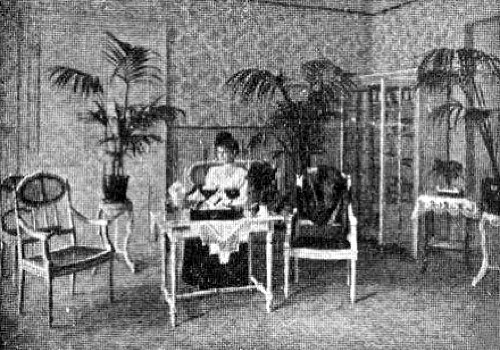
Above: 1903 The Adair salon at 5 Rue Cambon, Paris. The woman in the photograph appears to be Eleanor Adair.
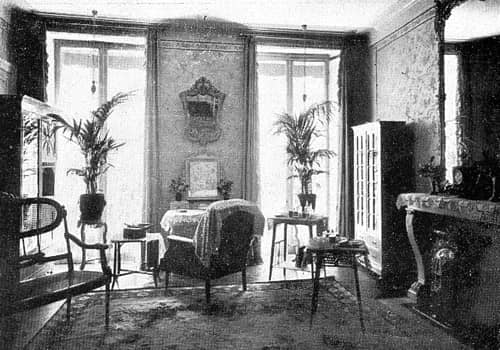
Above: 1907 The Adair salon at 5 Rue Cambon, Paris.

Above: 1912 The Adair salon at 5 Rue Cambon, Paris.
Ganesh
Although she named her salons after herself, Adair did not do the same for her products and treatments. She used her experience in India to claim that her ‘secrets’ had originated in the Vale of Kashmir on the Indian subcontinent or from a ‘Temple of Ganesh’, hence the name. The story of her ‘discovery’ was laid out in her booklet ‘Beauty Lore of East and West’, one of a number of advice booklets that Adair published over the years.
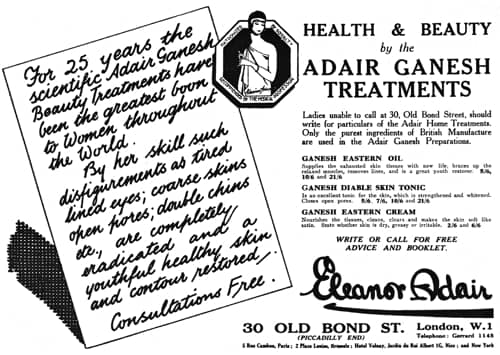
Above: 1927 Adair Ganesh Treatments.
Adair had probably accumulated some medical knowledge through her first husband’s work in the Royal Army Medical Corp. but her beauty advice was was also influenced by the nineteenth-century Physical Culture movement. Her numerous booklets contained activities ‘specially arranged for women’ which included breathing exercises, movements to improve posture as well as specific routines for areas like the face and the bust. However, women who found it difficult to do these routines could purchase a personally fitted Ganesh Parisian Corset to ‘improve their carriage’.
Salon treatments
Adair salons offered a range of beauty treatments including facials, massage, weight reduction, eye treatments and electrolysis. Her signature Strapping Electrical Treatment combined gentle finger patting over the face to reduce wrinkles, straps to lift and correct sagging tissue, vibratory massage to firm muscles, and electricity to stimulate nerves. These therapies were combined with Ganesh preparations including Ganesh Eastern Muscle Oil, Ganesh Skin Food and Ganesh Diable Skin Tonic to cleanse, ‘tone’ and ‘nourish’ the face and throat.
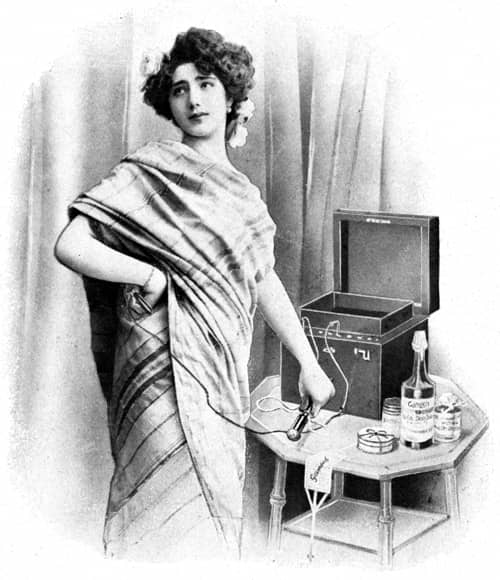
Above: 1906 Eleanor Adair standing next to a table displaying some of her Ganesh preparations, a chin strap and an Adair Electro-Coil Battery all used in her Strapping Electrical Treatment. The Indian (‘hindoo’) origins of her cosmetics are suggested by the sari.
Straps
Critical to the Strapping Electrical Treatment – later known as the Strapping Muscle Treatment – were chin straps. Adair claimed to have invented these and, in 1902, was granted two British Patents for a forehead and a chin strap.
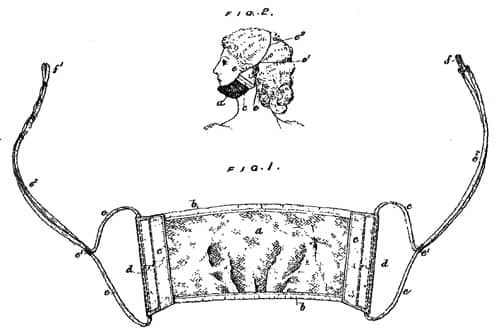
Above: 1902 Drawing for a chin strap from British Patent No. 9783 granted to Eleanor Huntley Nicholson (Eleanor Adair).
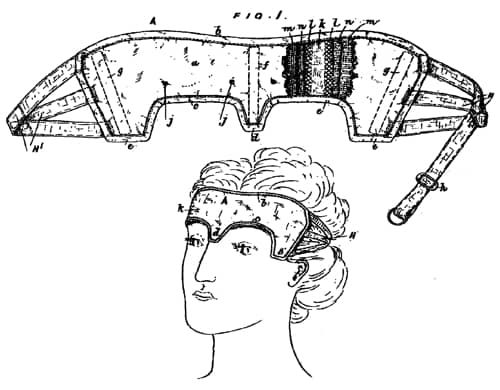
Above: 1902 Drawing for a forehead strap from British Patent No. 23540 granted to Eleanor Huntley Nicholson (Eleanor Adair).
There were different chin straps for double and flabby chins, both available for purchase for clients to use at home. Adair also recommended the stronger strap as a cure for snoring.
Some people say the eyes show the age, but it’s not really true. The true test is the chin, the contour. I always look first at the contour. … Moreover, you know there are two kinds of double chins. … One where there is a real fold of flesh added, and one where the muscles of the neck and cheek have sagged and become stringy. We have a strap adapted to each kind of chin, a muscle oil that goes with it, and anyone who is at all persistent in their use can face the world confident that she looks no older than she feels.
(The Theatre, 1915, p. 270)
Adair also sold forehead straps – in rubber and leather – some of which were medicated, and recommended that clients use both at home to firm up necks and smooth out facial lines. She also sold Ganesh Wrinkle Plasters presumably for use on expression lines around the eyes and mouth and there was a Domino Strap to help ‘cure puffiness under the eyes and remove lines’.
See also: Straps, Bandages and Tapes
Patting and tapping
When massaging the face and throat, Adair used kneading and tapping rather than broad strokes of the hands. This was done to avoid ‘stretching the skin’ which she thought led to wrinkles.
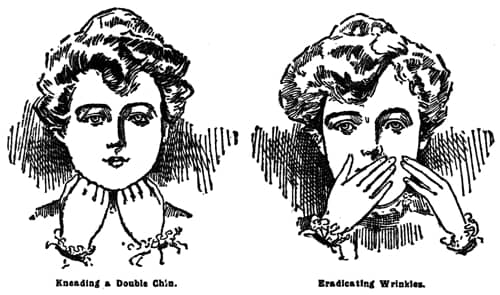
Above: 1903 Two Adair home treatment routines using kneading and tapping.
First—stand erect, brace the muscles of the neck, then half close the hands and press the backs of them very firmly against the throat kneading towards the side muscles; then, close the hands and knead up the middle of the cheek toward the temples doing this about twenty times; next, hold the skin under the eyes with the fingers of one hand; then, with the soft parts of the fingers of the other hand, pat and flip gently but firmly not against or across but on to the lines; finally, tap the forehead with the soft parts of the third and fourth fingers of both hands, and go gently over the eyelids, pressing lightly but firmly with three fingers of each hand.
(Adair advertorial, 1903)
Clients who found it difficult to use their fingers to do the tapping could purchase an Adair Patter and use it at home to stimulate the skin while they were patting in Adair creams and tonics.

Above: Patter sold by Eleanor Adair. The kit comes with two pads, one for tonic and one for cream.
[Adair] treatments has as its foundation strapping the muscles, assisted by the finest of creams, tonics and an Eastern muscle oil. There is a cleansing cream to clean the pores, a skin food to feed them, and the muscle oil to brace up the relaxed muscles. All of these are applied to the skin by the strapping or patting motion. A similar effect can be produced at home by the patter—a chamois pad at the end of a spring—which the originator of the system has invented. Two pads, one for the tonic and the other for the cream, are included.
(Adair advertorial, 1914)
See also: Patters
Adair supplemented gentle finger patting and straps with more vigorous massage movements such as vibration and tapotement but again these were done without stretching the skin. Salon staff could do these by hand but electrical vibrators were also used. Women who wanted to do something similar at home could purchase a Ganesh “La Frappe”, a small mechanical vibrator.
Ganesh “La Frappe”: “[A] small hand held vibrator (not a machine) for bracing the muscles and increasing the circulation.”
Steaming
Adair treatments were careful to avoid stretching the skin, so she was also against steaming. Adair thought it would make the skin lax and flabby and rob the skin of its oils, both outcomes that could lead to the development of wrinkles.
Instead of steaming the skin, which robs it of its natural oils, or the vigorous massaging, which stretches the tissues and often produces flabbiness, the skin is gently patted and strapped, increasing the blood circulation and training the flabby muscles into their proper place.
(Adair advertisement, 1913)
See also: Vaporisers (Steamers & Atomisers)
Electrical treatments
Electricity supplied by a battery was another component of the Strapping Electrical Treatment. The Adair Electro-Coil Battery delivered a Ganesh Uninterrupted Current – a continuous, direct (galvanic) current – through stick electrodes that had their ends filled with cotton wool soaked in Ganesh Diable Skin Tonic. The electricity ‘stimulated the nerves’ while the Ganesh Diable Skin Tonic toned and whitened the skin, contracted enlarged pores, reduced puffiness and worked as an antiseptic.
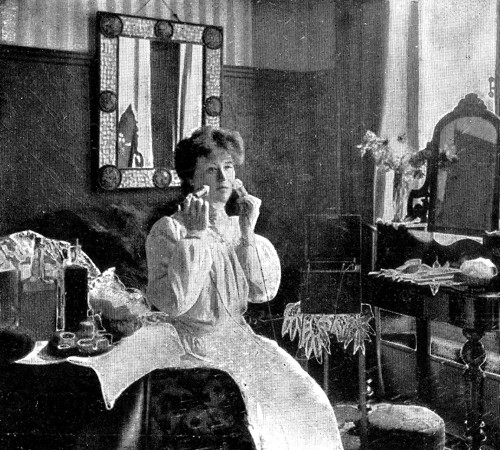
Above: 1903 An Adair salon, possibly at 90 New Bond Street, London, with an Electro-Coil Battery and electrodes.
When mains/street electricity became available, Adair added high-frequency (violet ray) treatments for a range of conditions including a number of nervous disorders that would now be considered to be medical conditions.
Not all are aware that the “Violet Ray” treatment is extremely beneficial for disorders of the nervous system—neuralgia, neurasthenia and the like—but that, nevertheless is the case. The powers that be at Mrs Adair’s, 92, New Bond Street W. 1. have had proof positive of its extraordinary efficacy; by its means they have been able to bring about many complete cures. Naturally, the more experienced the hand, the more effective the treatment, and one knows that Mrs. Adair employs only the most experienced of assistants, and that the results, therefore, could not be other than satisfactory.
(Adair Advertorial, Eve: The Lady’s Pictorial,, 1920)
See also: High Frequency
Mention should also be made of the Mask of Youth, a salon treatment introduced around 1928 that also used an electrical current. I have been unable to determine the manner of the procedure but it may have been similar to Lina Cavalieri’s Masque de Beauté which simply combined electricity with a skin tonic, something Adair had already been doing with stick electrodes.
See also: Lina Cavalieri
Eye treatments
Adair placed a good deal of emphasis on treatments for the eyes. Some of her advice booklets included exercise routines for the eyes and her Tappy Eye/Tired Eye Treatment – said to remove the appearance of ‘tired’ or ‘automobile eyes’, improve sight, and prevent lines and wrinkles – was a staple treatment in Adair salons for decades.
See also: Motor Skin
The salon treatment for the eyes started with Diable Muscle Oil patted in with gentle finger taps. A hot, herbal Bandalette was then draped across the eye area for five minutes or so, followed by a cold bandage which was left on during a light treatment. After the bandage was removed the area was then worked over with a galvanic current with the electrodes soaked in Ganesh Diable Skin Tonic.
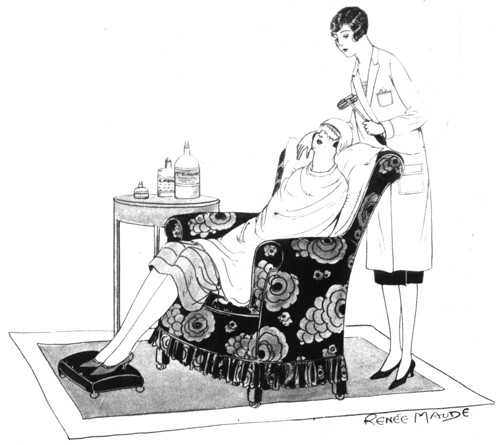
Above: 1925 Illustration of an Adair eye treatment in the salon at 92 New Bond Street. Note the applicator the therapist is holding to apply the hot Bandalette. “The Bandalette is placed over the eyes and the whole process, which is a miniature rest cure, need not occupy more than fifteen minutes.” (Adair advertorial, 1925).
There is also mention of a ‘light ironing cure’ in the 1920s. I have been unable to determine exactly what this was but I assume it was used to help remove lines and puffiness.
The regular “Tappy Eye Treatment” that Mrs Adair herself gives to so many of our leading society women, is a treatment that is eminently successful in restoring the beauty of the eyes, in strengthening their vision, and in soothing all the nerves that are in their vicinity. No one save those who have taken it knows the feeling of entire restfulness that comes while taking this eye treatment. With this tapping treatment Mrs. Adair combines electricity and the new light ironing cure. This treatment is wonderful for the lines and removes them altogether.
(Adair advertisement, 1909)
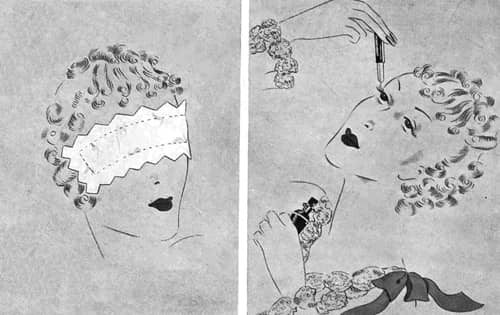
Above: 1936 Herb Bandalette and Marvelle Eye Drops.
Ganesh Strengthening Eye Drops and Marvelle Eye Drops could be used to help clear the eyes, reduce redness and improve the sight.
Her “Ganesh Strengthening Eye Drops” sold for $1.00 and “Ganesh Marvelle Eye Drops,” $1.25, for clearing eyes that are red and bloodshot, and giving them that winsome blue whiteness that ones sess in the eyes of little children, are made to the prescription of that Eye Specialist; and eyes that are wearied by long nights at bridge, or other excitements, should be washed night and morning with the former of those; while a drop or two of the latter put into the eyes just before a dinner party or dance, will make those eyes more brilliant and fascinating than usual, and prevent the usual tired ache.
(Adair advertorial, Vogue, 1906)
All of these products could be bought for use at home.
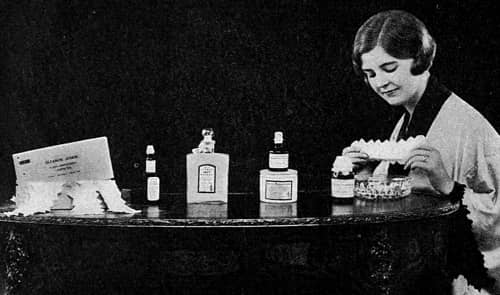
Above: 1931 A range of adair products including eye drops and Bandalettes.
Additional products for the eye area included Eyelash and Eyebrow Tonic Ointment for the eyelash and eyebrows to help them grow and Ganesh Anti-Puff Lotion to help remove bags under the eyes.

Above: 1934 Eleanor Adair Tonique (France). This was an eyelash grower not a cream mascara, said to improve the length and thickness of eyelashes if brushed on every night for two to three months. I doubt if the formula had changed much from the preparation Adair sold before the First World War.
Eyelash and Eyebrow Tonic Ointment: “Grows luxuriant, velvety lashes. Deepens color.”
Ganesh Eye Lotions; Ganesh Marvelle Eye Drops: “Eyes that are dull are made brilliant, and eyeballs that are yellow, or red, or bloodshot, are made clear.”
Ganesh Anti-Puff Lotion: “For bad puffs under the eyes … applied with a brush every second night for a week.”
Hair removal
Permanent hair removal by electrolysis was a staple treatment in Adair salons as it was in many others. Electrolysis was also used to remove warts, spider veins (telangiectasia), moles and purl spots (milia), all common treatments of the time although some would be avoided by therapists today.
Electrolysis under the skilful care of the Adair assistants, kills superfluous hair at the roots and removes moles, warts, purl spots and red broken veins without leaving a mark.
(Adair advertisement, 1932)
See also: Electrolysis
Superfluous hair could also be treated with Ganesh Dara, a ‘compounded wax-like preparation’ applied to the skin with a spatula that looks essentially like a hot-wax treatment. It was sometimes described as having a ‘cool, soothing effect on the skin’ and as being a ‘painless’ procedure, both claims that are difficult to believe.
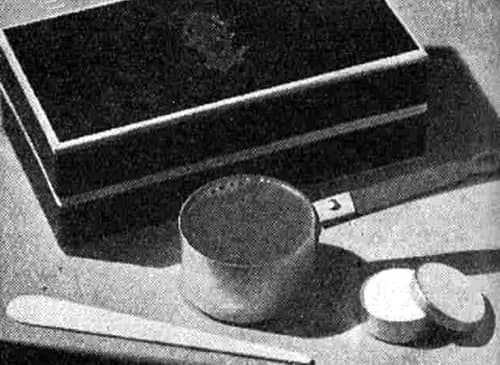
Above: 1934 Eleanor Adair Ganesh Dara Kit for use in the home.
See also: Waxing
Weight control
Like other therapists of her time, Adair subscribed to the belief that massage could build up and reduce flesh depending on how it was administered, both processes that could be enhanced with the addition of a suitable agents.
See also: Massage, Wrinkles and Double Chins
For clients wanting to develop areas of their body, such as the bust, Adair recommended doing postural postural exercises and massaging the area with Ganesh Juno.
Ganesh Juno: “For improving size and firmness of the neck and bust.”
See also: Bust Treatments
Superfluous fat, on the other hand, could be ‘rubbed away’ with massage combined with Ganesh Retardine.
Retardine: “[A] scientific ‘flesh reducer,’ which reduces flesh in a very short time.”
In the salon, a reducing massage could be done by a therapist but women could also buy a Swedish Rub-Away for use at home. These devices – which were not developed by Adair – came in a number of different forms for use on different parts of the body.
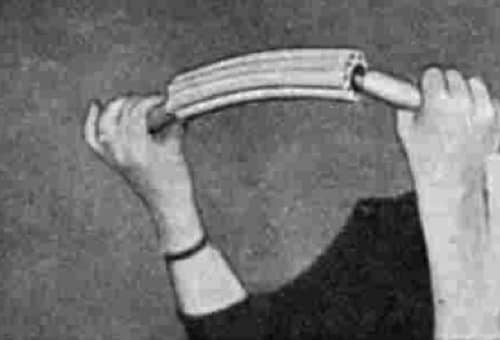
Above: 1928 Swedish Rub-Away (Rolling Pin Model) for use over larger areas of the body.
Clients wanting to lose weight could purchase the Rub-Away and Retardine, use an eleastic Ganesh Reducing Belt or Ganesh Bolerette, and/or add Ganesh Reducing Saltina to their bath.
Ganesh Reducing Belt: “[F]or reducing the figure below the waist and restoring suppleness.”
Ganesh Bolerette: “[F]or reducing stoutness under the bust and the bust itself; made to measure.”
Ganesh Reducing Saltina: “[R]emoves all unnecessary flesh”, and “promotes a healthy, youthful figure.”
Skin-care
By 1916, Adair had around fifty preparations in her product line to treat every ‘aging, fading, blemished condition of the skin’. Most of were still around some twenty years later.
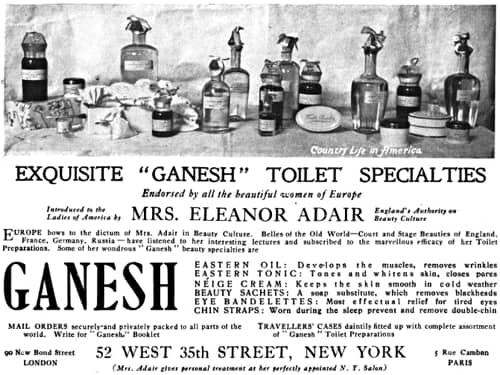
Above: 1904 An assortment of preparations from Eleanor Adair.
Adair subscribed to a typical cleanse, tone and nourish skin-care routine. First, the skin was cleansed with Ganesh Cleansing Cream – most likely a cold cream – to remove surface material and unclog the skin’s pores. Once this was done, Ganesh Diable Skin Tonic was then used to brace the skin and close the pores. The final step was the addition of ‘nourishing’ Ganesh Skin Food. If the situation required it, Ganesh Muscle Oil could be also be applied to ‘fill out the hollows of the face and improve the contour’.
Ganesh Cleansing Cream; Ganesh Balm Cleansing Cream: “Soothing and penetrating cream cleanses the pores of all impurities, leaving the skin smooth, soft and lovely.”
Ganesh Diable Skin Tonic; Ganesh Eastern Diable Skin Tonic: “[D]estined to be used instead of water, and is a splendid wash for the eyes. It strengthens the skin, enabling it to withstand the injurious effects of hot sun, cold winds, and constant changes of climate; neither must it be forgotten that it is an excellent wash for closing the pores.”
Ganesh Skin Food; Ganesh Eastern Balm Skin Food; Ganesh Eastern Skin Food: “Firms muscles and fills out hollows.”
Ganesh Muscle Oil; Ganesh Eastern Muscle Oil; Ganesh Muscle Developing Oil: “Effaces wrinkles; builds up sagging tissues; makes flesh firm and healthy.”
See also: Skin Tonics, Astringents & Toners, Skin Foods and Muscle oils
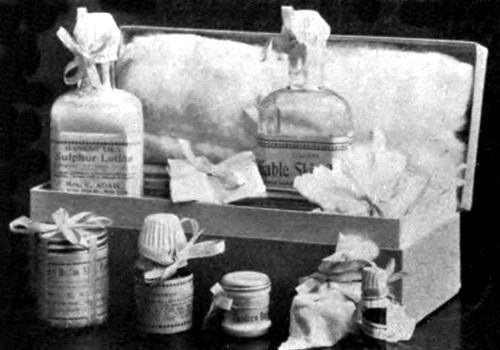
Above: 1915 Eleanor Adair Beauty Box containing Lily Sulphur Lotion, Diable Skin Tonic and a number of other preparations. These cosmetics seem to be made as part of a cottage industry and needed to be packed in large amounts of cotton wool to ensure the glass bottles did not break in transit.
For skins that were oily, Adair recommended Ganesh Beauty Sachets as a substitute for soap. She does not appear to have developed a oily skin cleanser until she introduced Complexion Milk – sometimes called Cleansing Milk – in 1934. Spagnette Cream (1928) made from Irish Bog Peat was also recommended for oily skin. The cream may have been efficacious as extracts of bog peat have antimicrobial properties.
Ganesh Beauty Sachets: “For use instead of soap on the face; especially valuable in removing blackheads and clearing the pores.”
Complexion Milk: “A soothing and cleansing lotion for day use; it is much more convenient than creams.”
Spagnette Cream: “[E]xtracted from the Irish Bog Peat, gives an attractive freshness to the skin.”
Adair also sold a range of preparations for skin problems including Ganesh Acne Lotion, Ganesh Freckle Cream and Ganesh Brown Spot Lotion.
Ganesh Acne Lotion: “An effective remedy for enlarged pores and blackheads.”
Ganesh Freckle Cream: “If applied at night will be found quite capable of keeping the skin untanned.”
Ganesh Brown Spot Lotion: “Removes brown spots and moth patches.”
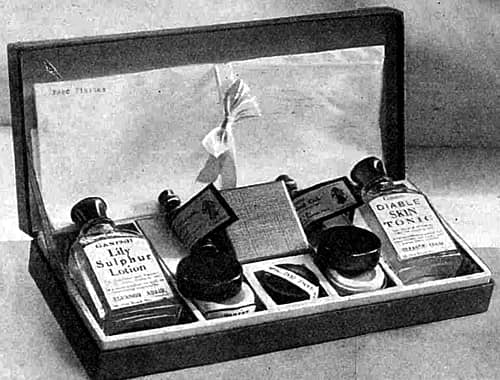
Above: 1933 Adair Beauty Box. Though the packaging is more sophisticated than the 1915 box shown previously, the product range is much the same.
Make-up
Adair was initially hostile to ‘paints’ claiming that “Simple Ganesh Methods [were] superior to ‘Make Up’.”
A poor complexion requires care: proper skin cleansing and nourishment will do more to beautify the skin and features than all the most wonderful artificialities.
(Adair advertisement, 1916)
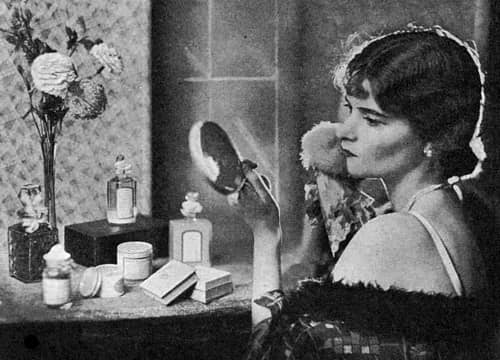
Above: 1929 An assortment of Adair products including Ganesh Face Powder.
Despite this hostility, Adair sold face powders and a range of tinted creams and lotions that could add colour to the face.
Ganesh Parisian Beauty Neige Cream: “Greaseless. Makes powder adhere, protects the complexion from chapping and keeps the skin soft and satiny.” Shades: Pink, Cream, and White.
Lily Sulphur Lotion; Ganesh Lily Lotion: “An incomparable liquid powder. Prevents and relieves tan and sunburn.” Shades: Pink, Cream, and White.
Ganesh Enameline: “To whiten neck and arms for evening.”
Ganesh Cactus Powder; Ganesh Flower Powder: “Finest quality, exquisitely perfumed.” Shades: Blond, and Brunette.
Ganesh Flower Bloom: “A harmless natural liquid rouge.”
Ganesh Koheul D’Orient: “A harmless oriental powder which gives the eyes a soft, fascinating shadow.”
It seems likely that Ganesh Parisian Beauty Neige Cream was a tinted vanishing cream, and that Ganesh Enameline and Ganesh Lily Lotion were liquid powders. The Ganesh Lily Lotion contained sulphur so was deemed more suited to women with an oily complexion.
See also: Vanishing Creams and Liquid Face Powders
By the 1930s, Adair had extended her range of make-up to include compact powders, paste rouges, lipsticks and cosmetiques (mascara). In 1932, the lipsticks and paste rouges came in Geranium, Maiden’s Blush, Pêche, Brique, Automn and Rose de Saadi tints, while the Cosmetique was blended in Corbeau, Brown and Black shades.
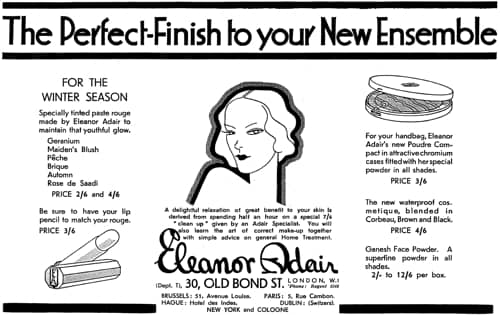
Above: 1932 Eleanor Adair Make-up.
Decline and closure
It would appear that Adair made a number of attempts to expand her business empire but was subject to increasing competition: Helena Rubinstein set up in London in 1908, then Paris (1909) and New York (1915); Elizabeth Arden opened in New York in 1910 then arrived Paris in 1920; and Dorothy Gray opened in New York in 1916. All of these new establishments encroached on her business.
After Helena Rubinstein announced her opening in New York, Adair took out a large advertisement titled ‘Ganesh the First’ suggesting that she was first in her field but it could also be read that she was here first! She repeated this line in numerous advertorials such as this one in the English version of Harpers Bazaar:
You owe it to your complexion to see Mrs.Adair first about that blemish. Remember she was the first to specialize in her field. That she offers you the results of a long and practical experience. That her constant and analytical study of complexion and contour has resulted in the perfection of no less than fifty Ganesh Preparations and Appliances, each with their individual use.
That her long established Salons in London and Paris are as busy today as they were before the war, so essential is the service they render to woman of refinement.
Discover how youthful you can look after a Ganesh (Original) Strapping Muscle Treatment, administered by English experts, at Mrs. Adair’s New York Salon. Learn of the permanent results which can be accomplished by a course of treatments.(Adair advertorial, Harpers Bazaar, 1916)
Adair was still making similar claims in the 1930s, if perhaps a little more stridently but, by then, she had closed shop in New York. The salon there seems to have been precarious with frequent changes of address including 52 West 35th Street, 15 West 39th Street, 21 West 38th Street, 557 Fifth Avenue and 23 East 56th Street. The Wall Street crash of 1929 may have been the deciding factor in her permanently closing operations in New York and the following Depression also led her to drop the prices of her salon treatments and cosmetics elsewhere.
Adair’s business practices may also have counted against her. She had a history of short-lived business arrangements: an agency with André in Rio de Janeiro, and another in Washington run by a Miss Edes did not last long; and Emily Yorke, who appears to have looked after the New York salon for a while, also seems to have left after a few years.
In addition, although Adair advertised to chemists in Britain to sell her products I have no evidence that her cosmetics were sold in department stores there or that they were widely distributed in the United States. I imagine that most were sold through her salons or selected agencies which reduced the size and resilience of her business.
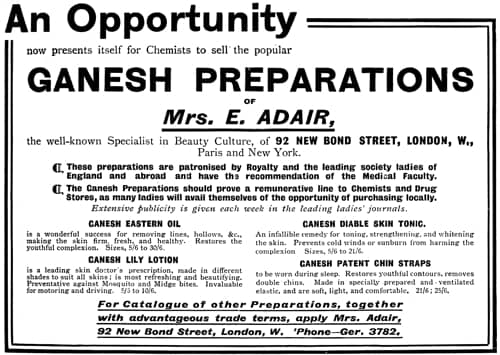
Above: 1914 Eleanor Adair industry advertisement looking for chemists to sell her products in Britain. To make her products more appealing to chemists, Ganesh Lily lotion is recommended for mosquito and midge bites, and Ganesh Lily lotion is listed as a sunburn and cold wind preventative.
There was also very little change in her product line or in the treatments she offered in her salons so her practice lacked the novelty offered by other larger salons during the 1930s.
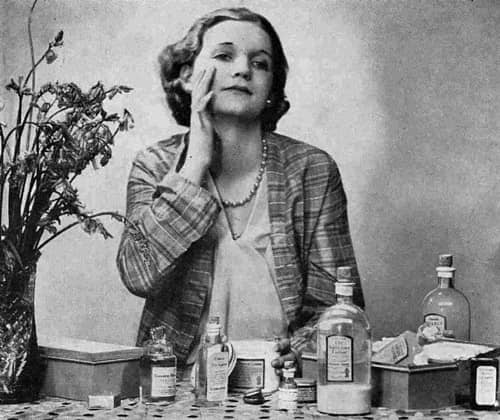
Above: 1931 Eleanor Adair products.
It is also possible that she simply retired. By the time the Second World War broke out she would have been in her seventies. Whatever the reason for the closure, unlike Elizabeth Arden, Helena Rubinstein or Dorothy Gray, there was no prosperous business to sell, so when she left the industry her name disappeared as well. This does not depreciate her role in the development of Beauty Culture. Many of her treatments were copied by Elizabeth Arden and then passed on to Dorothy Gray and others.
Timeline
| 1900 | London salon opens at 90 New Bond Street. |
| 1902 | Paris salon opens at 5 Rue Cambon. |
| 1903 | New York salon opens 52 West 35th Street. |
| 1904 | Agency opens in Washington D. C. |
| 1905 | Salon opened at Carlton House, High Street, Birmingham. |
| 1906 | London salon moved to 92 New Bond Street. |
| 1920 | Agency opens in Rio de Janeiro. |
| 1923 | Brussels salon opens at 2 Place Louise; later moved to 51 Avenue Louise. |
| 1927 | London salon moves to 30 Old Bond Street. New Products: Spagnette Cream. |
| 1933 | London salon moves to 149 New Bond Street. |
| 1934 | New Products: Herbal Pack; and Complexion Milk. |
| 1935 | New Products: Lettuce Leaf Cream. |
First posted: 10th October 2011
Last Update: 6th June 2022
Sources
Eve: The lady’s pictorial. London.
Shuker, N. (2001). Elizabeth Arden: Beauty empire builder. Woodbridge, CT: Blackbirch Press.
The theatre: Illustrated monthly magazine of dramatic and musical art. (1915). Vol. XXI, New York: The Theatre Magazine Company.
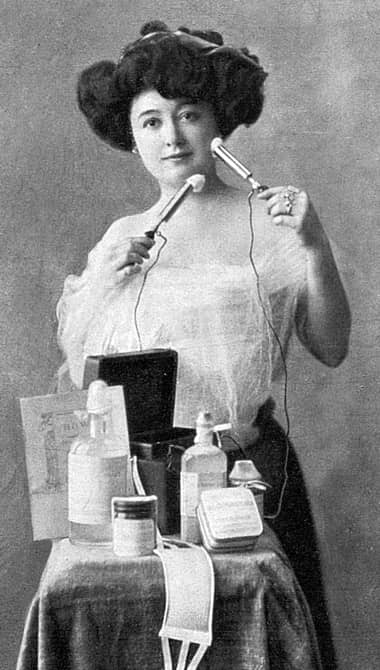
Eleanor Adair [b. 1864] a.k.a Eleanor Agnes Hanley.

1900 Eleanor Adair.
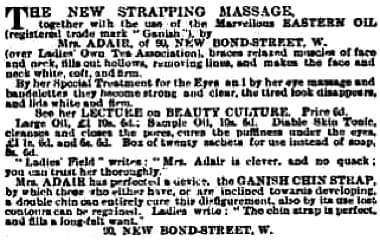
1901 Eleanor Adair. This advertisement uses the word Ganish rather than Ganesh. Other advertisement did the same until 1902.
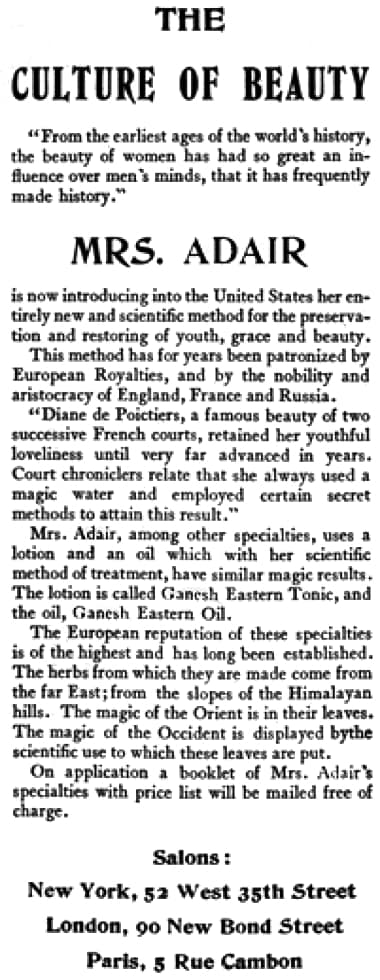
1903 Eleanor Adair salons in London, Paris and New York.
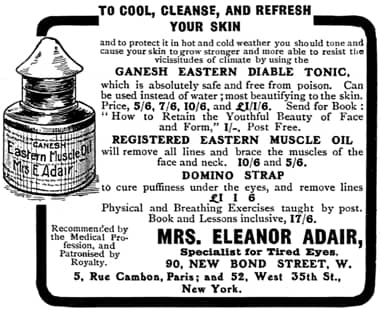
1904 Eleanor Adair Ganesh Eastern Diable Tonic and Registered Eastern Muscle Oil.
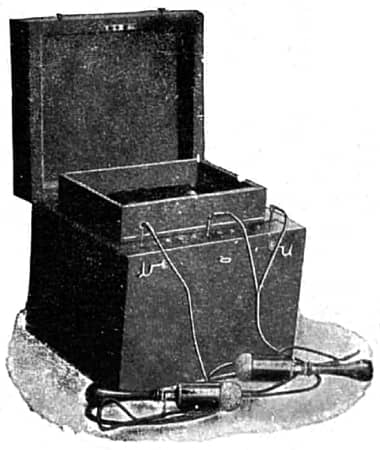
1904 The Adair Electro-Coil Battery. Clients could purchase one for use at home.

1905 Eleanor Adair Chin Strap and Ganesh Muscle Oil.
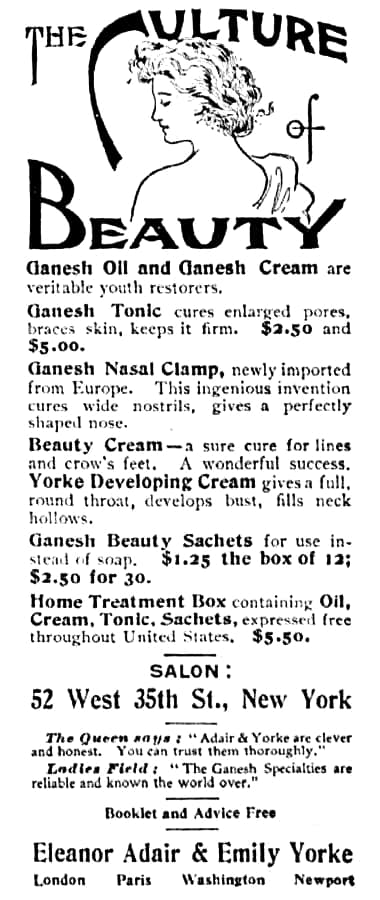
1905 Eleanor Adair. Note the mention of Emily Yorke and the Yorke Developing Cream. It was very unusual for Adair to give this much credit to someone else.
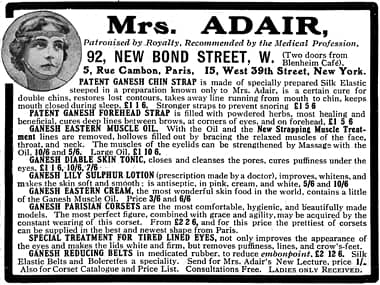
1906 Eleanor Adair products including Ganesh Parisian Corsets and Ganesh Reducing Belts.
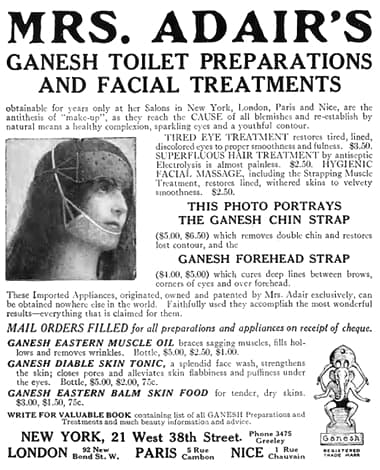
1912 Eleanor Adair Toilet Preparations and Facial Treatments with the Ganesh trademark
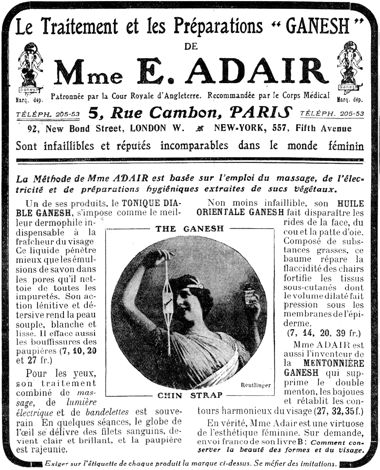
1913 Eleanor Adair.

1915 Eleanor Adair. The Safe & Sure Treatment.
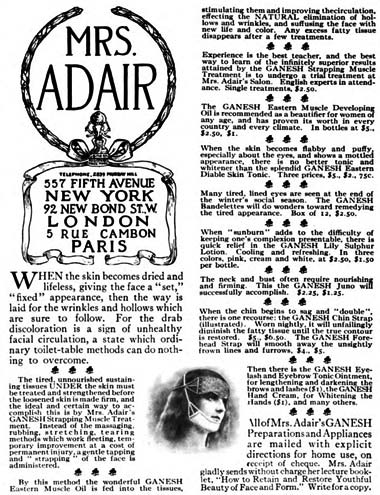
1915 Eleanor Adair treatments.
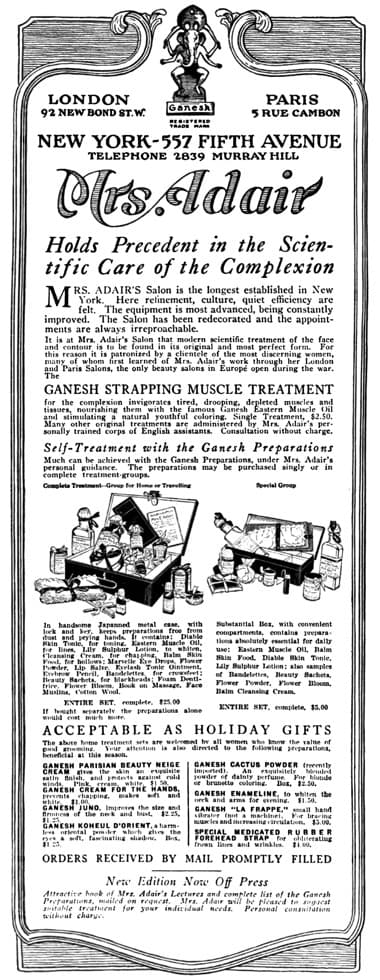
1916 Eleanor Adair.
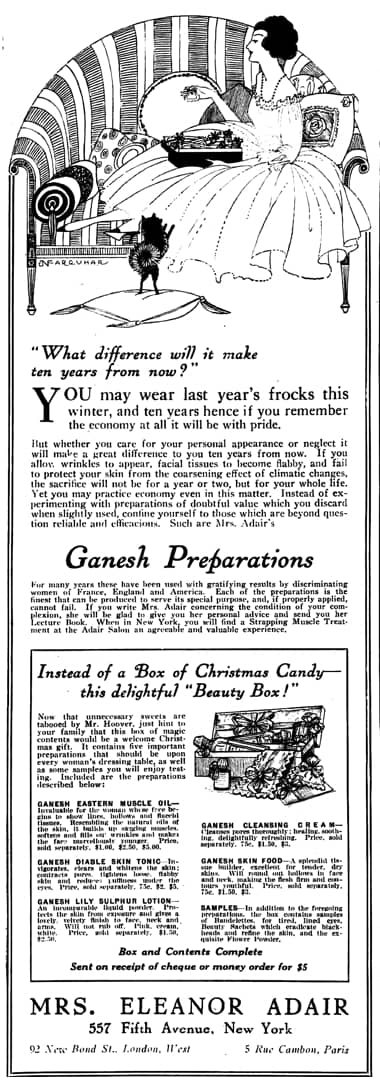
1917 Eleanor Adair.

1917 Dara hair remover.
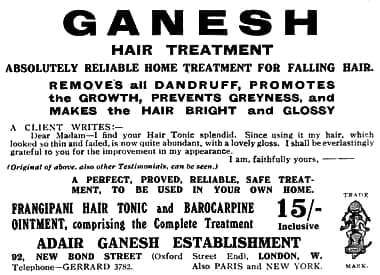
1918 Eleanor Adair hair treatments.
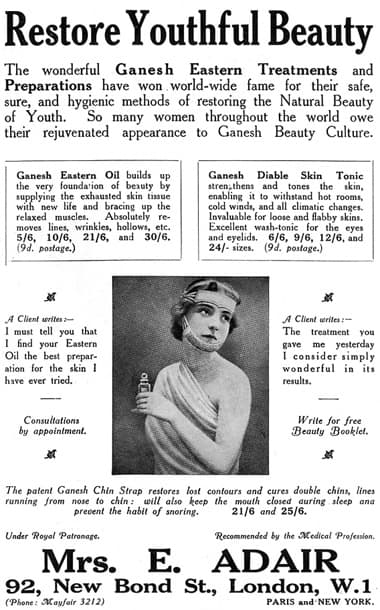
1922 Eleanor Adair Restore Youthful Beauty. These straps appear to be made of fabric.

1923 Eleanor Adair Ganesh Strapping Muscle Treatment.
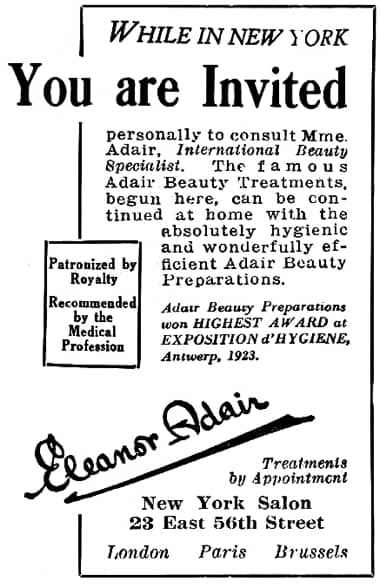
1924 Eleanor Adair.
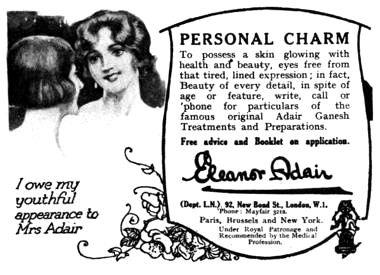
1924 Eleanor Adair.
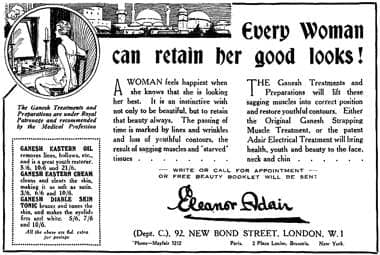
1925 Eleanor Adair.
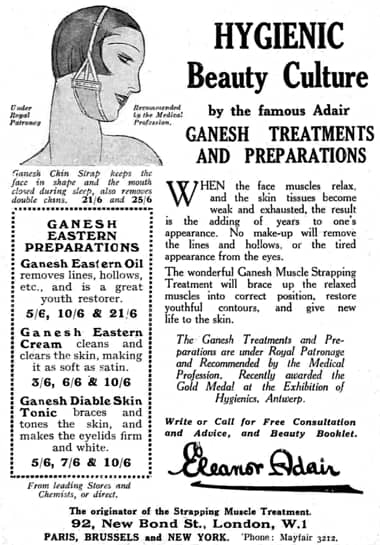
1926 Eleanor Adair.
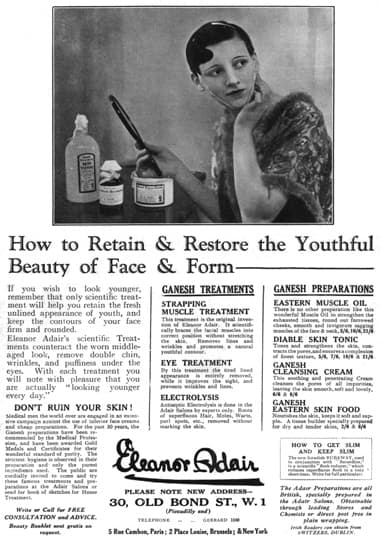
1927 Eleanor Adair treatments and preparations. Note the chin strap the model is wearing. The bottle on the left is Ganesh Diable Skin Tonic, the cream on the right is probably Ganesh Eastern Skin Food.
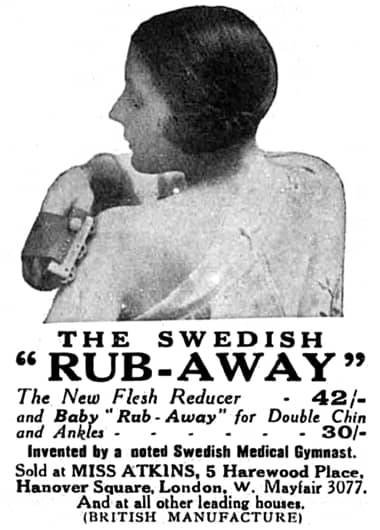
1927 Swedish Rub-Away.
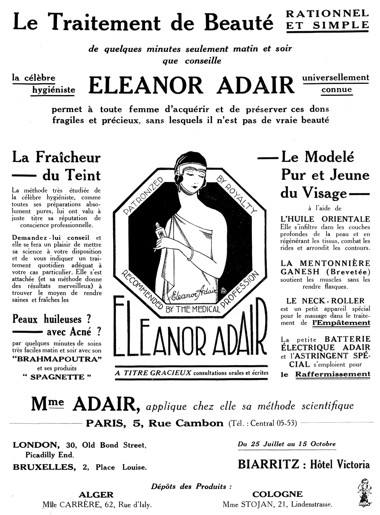
1927 Eleanor Adair Beauty Treatments.

1929 Eleanor Adair eye treatment.

1929 Client having a mechanical massage treatment over a chin strap in an Eleanor Adair salon.
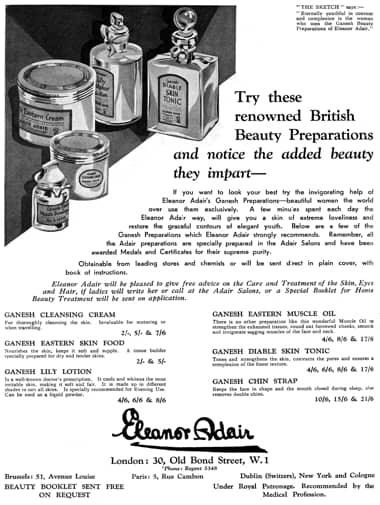
1931 Eleanor Adair.
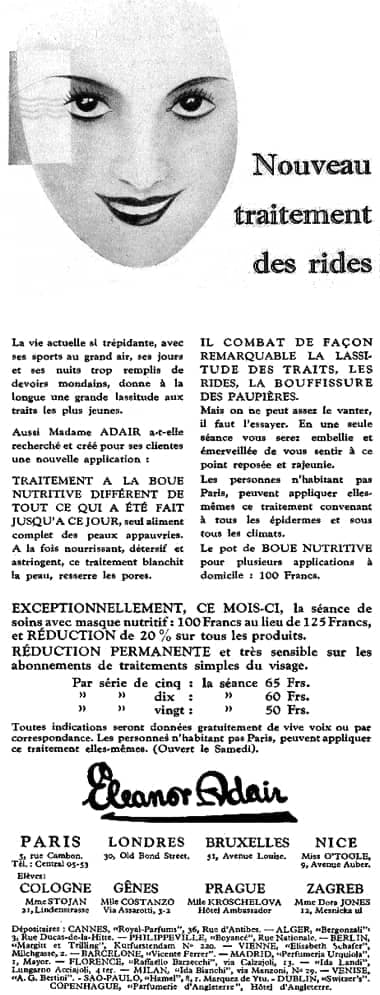
1932 Eleanor Adair ‘New Treatments for Lines’. There are salons in Paris, London, Brussels, Nice, Cologne, Geneva, Prague and Zagreb and products can also be purchased in Cannes, Algiers, Philippeville, Berlin, Vienna, Barcelona, Madrid, Florence, Milan, Venice, San-Paulo, Dublin and Copenhagen.
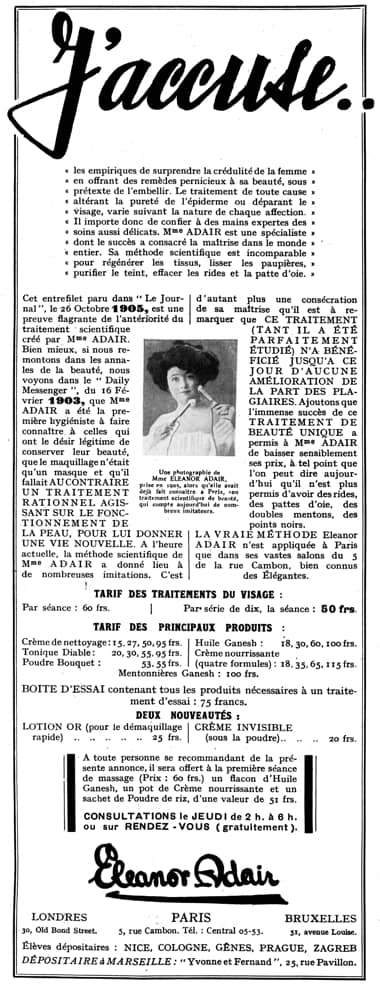
1933 Eleanor Adair. This advertisement states that she was here first, that her treatments have been copied but not bettered, all indications that there was increased competition which, along with the economic depression, led her to drop her prices.
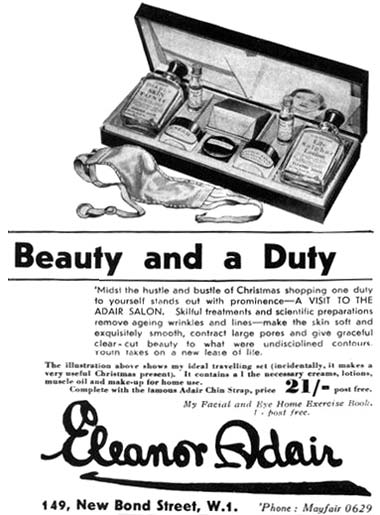
1934 Eleanor Adair Beauty Box. Not much has changed since 1915. Diable Skin Tonic on the left, Lily Sulphur Lotion on the right. The Beauty Box also contained a chin strap that appears to be similar to the one from the 1920s.
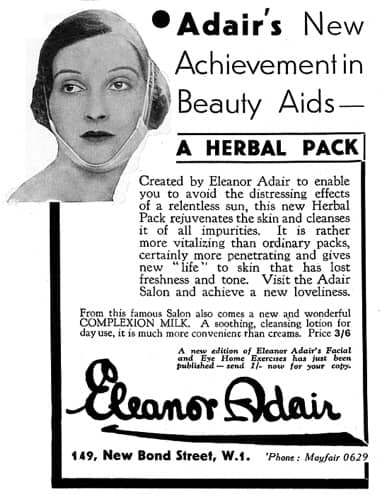
1934 Eleanor Adair Herbal Pack.
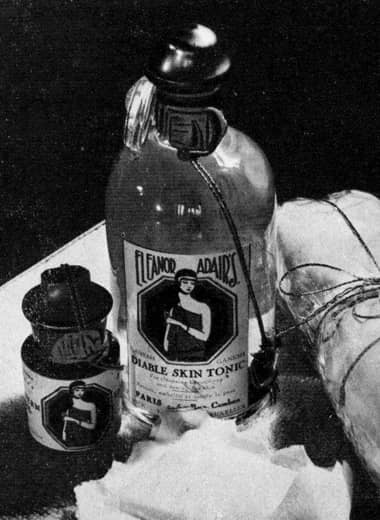
1934 Eleanor Adair Diable Skin Tonic (France).

1936 Eleanor Adair Scientific Eye treatment.
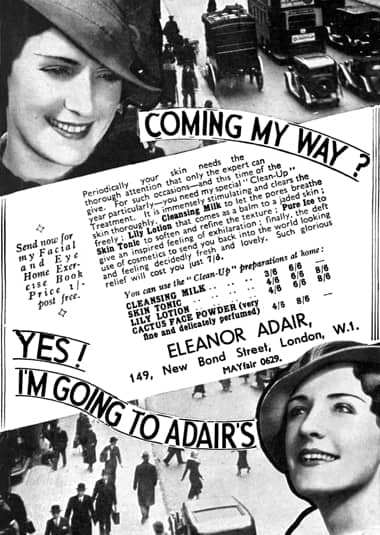
1936 Eleanor Adair.
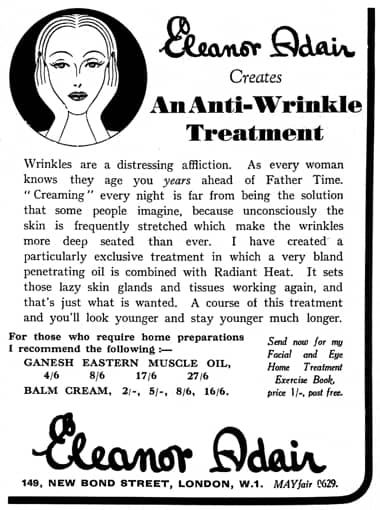
1937 Eleanor Adair Anti-Wrinkle Treatment.
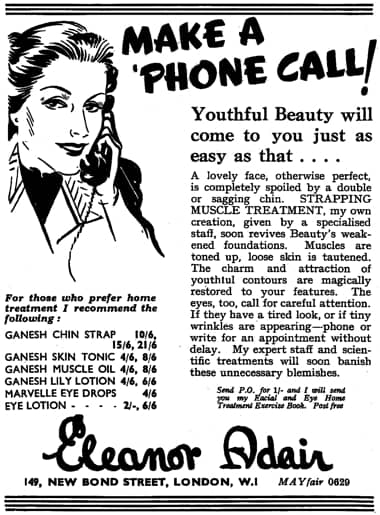
1937 Eleanor Adair.
